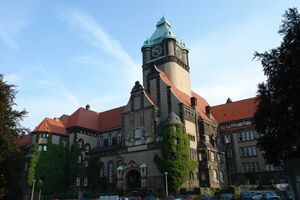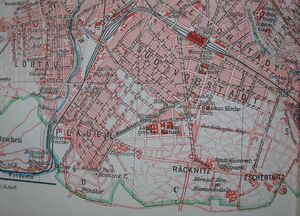Dresden University of Technology
(University) | |
|---|---|
 | |
| Formation | 1828 |
| Headquarters | Dresden, Germany |
| Sponsored by | Mercator Foundation |
| Strong technical tradition | |
The Dresden University of Technology (Technische Universität Dresden, abbreviated as TUD) is a public research university, the largest institute of higher education in the city of Dresden, the largest university in Saxony and one of the 10 largest universities in Germany with 32,389 students as of 2018.[1]
The name Technische Universität Dresden has only been used since 1961; the history of the university, however, goes back nearly 200 years to 1828. This makes it one of the oldest colleges of technology in Germany, and one of the country’s oldest universities.
Contents
History
In 1828, with emerging industrialization, the "Saxon Technical School" was founded to educate skilled workers in technological subjects such as mechanics, mechanical engineering and ship construction. In 1871, the year the German Empire was founded, the institute was renamed the Royal Saxon Polytechnic Institute (Königlich-Sächsisches Polytechnikum). At that time, subjects not connected with technology, such as history and languages, were introduced. By the end of the 19th century the institute had developed into a university covering all disciplines. In 1961 it was given its present name, Technische Universität Dresden (Dresden University of Technology).
Upon German reunification in 1990, the university had already integrated the College of Forestry (Forstliche Hochschule), formerly the Royal Saxony Academy of Forestry, in the nearby small town of Tharandt. This was followed by the integration of the Dresden College of Engineering (Ingenieurshochschule Dresden), the Friedrich List College of Transport (Hochschule für Verkehrswesen) the faculty of transport science, and the “Carl-Gustav Carus” Medical Academy (Medizinische Akademie or MedAk for short), the medical faculty. Some faculties were newly founded: the faculties of Information Technology (1991), Law (1991), Education (1993) and Economics (1993).
In 2009 TU Dresden, all Dresden institutes of the Fraunhofer Society, the Gottfried Wilhelm Leibniz Scientific Community and the Max Planck Society and Forschungszentrum Dresden-Rossendorf, soon incorporated into the Helmholtz Association of German Research Centres, published a joint letter of intent with the name DRESDEN-Konzept - Dresden Research and Education Synergies for the Development of Excellence and Novelty, which points out worldwide elite aspirations, which was recognized as the first time that all four big post-gradual elite institutions declared campus co-operation with a university.
Research
The TU Dresden benefits from the strong research tradition in microelectronics and transport sciences in the Dresden area, but also from the establishment of new research fields such as Biotechnology.
Biotechnology and Medical Technology
The university has established a strong partnership with the Max Planck Institute for Molecular Cell Biology and Genetics in molecular bioengineering. As part of the German Universities Excellence Initiative, the Deutsche Forschungsgemeinschaft has decided to fund the Cluster of Excellence "From Cells to Tissues to Therapies: Engineering the Cellular Basis of Regeneration" (DFG-Center for Regenerative Therapies Dresden), as well as a new graduate school, the "Dresden International Graduate School for Biomedicine and Bioengineering" with about 300 PhD students.
The Center of Biotechnology ("BIOTEC") is a unique interdisciplinary center focusing on research and teaching in molecular bioengineering. The BIOTEC hosts top international research groups dedicated to genomics, proteomics, biophysics, cellular machines, tissue engineering, and bioinformatics.
Magnetism and Material Sciences
The Deutsche Forschungsgemeinschaft funds research in the area of electromagnetic flow influence in metallurgy, artificial crystal formation and electrochemistry. Other research is done on the Meissner effect and artificial fibers (textile).
Micro and Nanotechnology
Silicon Saxony is the biggest cluster of the microelectronics industries in Europe. TU Dresden is incorporated in this network with three departments of the Faculties of Electrical Engineering and Sciences. Together with the Fraunhofer Center for Nano-electronic technologies (CNT) it represents one of the leading universities in the field of nanotechnology. There is also a research cooperation with some semiconductor fields of TU Freiberg. In May 2012 the Helmholtz-Kolleg NANONET was founded.
Transport
The university has a partnership with the Fraunhofer-Institut for Transport and Infrastructure systems to research on IT-systems for public transport in Dresden.
Business and Economics
In partnership with TU Dresden, the Ifo Institute of Economic Research (Ifo Institut für Wirtschaftsforschung e.V.) is researching the economic development in Eastern Germany.
The university belongs to a consortium of European Universities offering the Erasmus Mundus Joint Doctoral Programme IT4BI-DC for Business Intelligence.
Other research areas
The Deutsche Forschungsgemeinschaft supports the university in many areas and TU Dresden cooperates closely with renowned research institutes such as Fraunhofer Society, Gottfried Wilhelm Leibniz Scientific Community and Max Planck Society.
Neuromorphic computing facility
TU Dresden received a grant of 8 million euro from the EU's Human Brain Project to build the second generation spinnaker computer called spincloud.[2]
Notable people
Faculty
- Manfred von Ardenne – Physics
- Heinrich Barkhausen 1911–1953 (not continuously) – Communications technology. Discoverer of the Barkhausen jumps, a manifestation of domain wall movement in magnets.
- Alfred Baeumler 1924–1933 – Nazi-philosopher and educationalist
- Kurt Beyer – Civil engineering
- Manfred Buchroithner — Cartography
- Adolf Busemann – Aerodynamics
- Carl Gustav Carus – Medicine
- Gerhard Fettweis – Engineering
- Klaus Fuchs – Nuclear technology, soviet spy
- Hanns Bruno Geinitz – Geology
- Gustav Kafka 1923–1934 – Psychology
- Victor Klemperer 1920–1935 – Professor for romance studies; He wrote “LTI”, an analysis of the Nazi's language, and detailed dairies during the Nazi time.
- Richard Kroner 1924–1928 – Philosopher (Religion)
- Luise Krüger – Athlete
- Günther Landgraf – Physics, first freely elected rector of TUD
- Nikolaus Joachim Lehmann 1921–1998 – Mathematician, professor, first lectures in informatics in the GDR 1967
- Wilhelm Gotthelf Lohrmann – Astronomer, Geodete
- Richard von Mises – Mathematician, Professor for Hydro- und Aerodynamics
- Maria Reiche - (1903-1988) - mathematician, archaeologist, and technical translator has studied in this University.
- Roland Scholl 1918–1934 – Chemist; director of the institute for organic chemistry
- Wilhelm Steinkopf 1919–1940 – Chemist
- Paul Tillich 1925–1929 – Philosopher (Religion)
- Gustav Zeuner – Engineer
Alumni
- Afroz Ahmad
- Carl Theodor Albrecht – Surveyor
- Fritz Bleyl – (Architecture) Architect and painter of expressionism
- Kwong-Chai Chu (朱光彩) – Chinese hydraulic engineer who received his CIE (Chinese Institute of Engineers) Award in 1947
- Carl Enckell – (Mechanical Engineering) Finnish politician
- Erik von Frenckell – (Engineering) a sports administrator, member of IOC and vice president of FIFA
- Steffen Heidrich – (Business Management) Former footballer
- Rudolph Hering – (Civil Engineering)
- Katja Kipping – Chairwoman of German Left Party
- Max Littmann – (Civil engineering) Architect
- Reimund Neugebauer – (Mechanical Engineering) Designated President of Fraunhofer Society
- Theodor Pallady – Romanian painter
- Evgeny Paton – (Engineering) Ukrainian
- Ernst Otto Schlick – (Engineering) Shipbuilding engineer
- Herbert Seifert – Mathematician
- Johannes Paul Thilman – (Science of Culture) Composer
- Stanislaw Tillich – (Mechanical Engineering) Minister-President of Saxony
Sponsor
| Event | Description |
|---|---|
| Mercator Foundation | German foundation financing projects of deep state interest and buying control over the narrative, especially on "climate change" and pro-migration. Frequently connected to censorship initiatives. |
An Alumnus on Wikispooks
| Person | Born | Nationality | Summary | Description |
|---|---|---|---|---|
| Stanislaw Tillich | 10 April 1959 | Germany | Politician | Minister-President of Saxony 2008-2017. In 2018 he co-chaired the German government's Coal Commission tasked to make a plan to phase out coal. |

